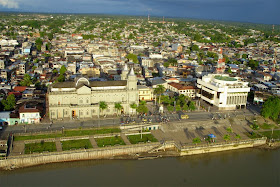 |
| Alexandra |
So Mom told the Plan website that she wanted to sponsor a girl who was between 14 and 16, anywhere in South America. And the girl that showed up first was Alexandra, from Colombia. So Mom agreed to sponsor her, without even looking at any other choices. Alexandra just turned 15 last week, and she has a twin brother whose name is Alexander. They live with their mother in a house that is made out of unfired mud bricks, with a corrugated metal roof. Their father is "absent," so we don't know if that means he went somewhere else to get a job and support the family or if it means he abandoned the family.
 |
| Alexander and Alexandra |
Mom and I did not know a whole lot about Colombia, but we did some in-depth research, and now we know more than we did before. Colombia is located at the northwest end of South America, and Panama hooks up with it. In fact, Panama used to be part of Colombia, but later it got to be its very own country. Colombia is the only country in South America that has a coast on both the Atlantic and the Pacific. It was named for Christopher Columbus, even though he never actually went there personally.
 |
| The department of El Chocó is in orange. Quibdó is the little spot in the department. |
The town where Alexandra lives is called Quibdó, and it was founded in 1654 by some Jesuit priests. It is located in the department of El Chocó. A "department" is what we would call a "state." I don't know why the South Americans use this word for it, but they do. Anyway, Quibdó has a population of about 150,000 people. It is on the bank of the Atrato River, which if you look at the photos below, you can see it is really wide and muddy-looking. I would not want to fall into that river because I am afraid I would drown. Also there might be crocodiles or something in it, but we did not research whether there are any or not.
 |
| Quibdó on the Atrato River |
So this department of El Chocó is mostly flat and full of jungles. It is a really hot and humid place, and it rains all the time there. One website I looked at said that Quibdó is the 5th wettest place in the whole world, but the Plan information said it was the 2nd wettest place. So I don't know who is right and who is wrong. What I do know is that every month, they get between 20 and 30 inches of rain, which adds up to about 354 inches every year. And this is another reason why I would never want to live there, because you know how much I hate having to go out to potty in the rain! Oh, and the minimum average temperature all year round is 86ºF, and the maximum average is 90ºF. So this means it's either hot or hotter all the time, and we think they probably don't even have air-conditioning!
 |
| The marketplace |
The people who live in Quibdó make a living by doing stuff like driving motorcycle taxis, loading and unloading cargo, selling fruit and fish and other stuff in the market, working in domestic service, and mining. We don't know how Alexandra's family gets along, since the father is "absent" and the mother is a housewife. But Alexandra and her brother go to school, so the family must get some income somehow.
 |
| Another view of Quibdó |
Okay, so maybe you are wondering how there got to be lots of black people from Africa living in Colombia. Well, it turns out that their ancestors came there as slaves, just like what happened in the U.S. The Spaniards started out using the native people to do their work, but then the natives kept dying, so the Spaniards imported African slaves beginning about 1500. The main work the slaves did was in gold mines, on sugar plantations, and on large cattle ranches.
Slavery was abolished in 1851, but life was still hard for the Afro-Colombians. They had to live in isolated places in the jungle in order to stay safe. Then in 1945, the department of El Chocó was created especially so that the Afro-Colombians would have a place where they could govern themselves and keep their culture alive.
 |
| The Cathedral |
In Colombia there is a group of scary, bad people called Las Fuerzas Armadas Revolucionarias de Colombia -- Ejército del Pueblo, or FARC-EP for short. In English this means The Revolutionary Armed Forces of Colombia -- People's Army. This group says that it is fighting for the poor peasants against the rich people, and it believes in Marxist and Leninist ideals. But the governments of the United States, the European Union, Canada, Colombia, Chile, and New Zealand say that FARC-EP is just a bunch of terrorists. FARC-EP is always going around kidnapping people and killing people and making money off of the illegal drug trade. So the Colombian people are afraid of them, and many have had to leave their homes because of all the bad fighting that FARC-EP has caused.
 |
| Homes on the Atrato River |
No comments:
Post a Comment